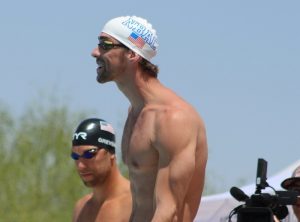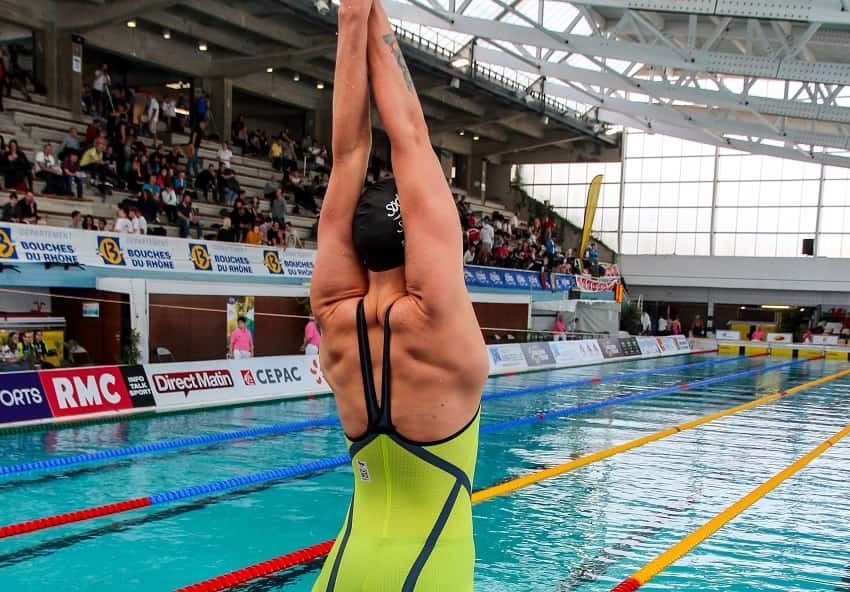Although swimming is a relatively low-risk sport for injury, shoulder pain is still a very common complaint in competitive swimmers. When you consider that elite swimmers are racking up over 8km in the pool each day, with the arms being the main propeller in the water, the prevalence of shoulder pain is not surprising at all.
Causes Of Shoulder Pain In Swimmers
Numerous studies have discussed how weakness or muscular imbalance of the rotator cuff and shoulder muscles are common reasons for shoulder pain in swimmers. As outlined in Part 1 of our Swimmer’s Shoulder Series, the strengthening and tightening of the inward rotators of the shoulders can leave the outward rotators out of balance. The weak and overstretched outward rotators of the shoulders contribute to the rounding forward of the shoulders commonly seen in swimmers.
Moreover, the chest (Pectoralis Major) and latissimus dorsi muscles, which are also internal rotators, play a major role in swimming strokes during the propulsion phase. With high volumes of mileage per week and hours spent swimming, it is very common for these muscles around the front of the shoulder to become overdeveloped, leading to strength imbalances between the front and back shoulder. This tightening or adaptive shortening of the chest and shoulder can inhibit activation of opposing muscle groups, while increasing inward rotation and forward tilting of the shoulder blades. This further increases the forward slumping and hunching of the shoulders in competitive swimmers.
Improve Swimming Performance As Well As Reduce Shoulder Injuries
It is important to note that these muscle imbalances and postural changes also reduce swimming performance, as well as increase the risk of shoulder pain. This is because the muscle lengths and angles of pull are not where they should be, so the muscle is not able to generate power in an optimal way. This reduction in power generation inhibits your swimming performance because you muscles can’t pull you through the water as powerfully as they should do. So, with poor posture you not only limit the mobility of your shoulders, but also dramatically short-change the amount of power you can exert.
Exercise Programs For Swimmers
Before starting a corrective strengthening program, coaches should assess the range of motion of the shoulder musculature in common swimming postures (i.e. streamline position) to identify tightness surrounding the shoulder blades and chest region. If tightness is identified, stretching of tight structures should be used early in the rehabilitative process.

Once adequate flexibility has been achieved, a functional strengthening program should be designed to initiate firing of the muscles that control the shoulder blades. As swimmers progresses through the program, emphasis should shift to dynamic control to restore muscle balance with various arm movements in more outer-range positions. Once muscle balance is achieved, the final emphasis is on swimming-specific strengthening of the shoulder and scapula (shoulder blade) muscles, using swim-specific movement patterns and positions.
In a study performed by Swanik, he integrated a 6-week dry-land functional training program to a group of competitive swimmers. The functional training program comprised of seven exercises performed three days per week that closely mimic the demands of swimming and emphasised training the shoulders in vulnerable positions. The group of elite swimmers that underwent the 6-week dry-land functional training reported significantly less incidence of shoulder pain. Significant overall improvements in strength were demonstrated for inwards rotation of the shoulder post-functional training as well. It is proposed that the significant reduction of shoulder pain is the result of muscular adaptations and strength resulting in improved muscle efficiency throughout the swim stroke.
Shoulder Stability Is Critical For Shoulder Health And Swimming Performance
The other part of the healthy shoulder equation involves improving the stability and mobility of the shoulder blades. A stable shoulder blade provides a solid base from which your shoulder joint can generate maximum force and power. A stable and strong shoulder blades equates to more power and speed in the water, as well as a reduction in your risk of shoulder pain.
As well as a stable shoulder blade, it is important to have good stability within the shoulder joint itself. Shoulder stability is controlled by static structures (i.e. ligaments and capsule around the shoulder and arm bone) and dynamic structures, primarily the rotator cuff muscles. Loss of the static component (eg ligament laxity after a shoulder dislocation or subluxation) means that the dynamic stabilisers (the rotator cuff muscles) need to work harder to contribute more to keep the shoulder stable. This often results in tissue overload, fatigue, micro-trauma to the cuff tendons and other structures, and eventually pain and injury.
Clinicians studying the effects of muscle fatigue with regards to stability of the shoulder blades showed that muscle fatigue interfered with the normal co-ordination and stability of the shoulder blades. This predisposes swimmers to abnormal shoulder movement patterns in the water, and over time poor swimming techniques leads to impingement, tendinopathy, instability and pain.
Swimming Stroke Correction Is Important Too
A common technical mistake made by swimmers is “dropping the elbows” as the hand enters the water. This results in an increase in outward rotation of the shoulder, placing unnecessary stress on the dynamic stabilisers (rotator cuff, biceps, and shoulder blades muscles). It has been documented that with fatigue, a muscle’s capacity to absorb energy is reduced, thus compromising dynamic joint stability. In swimming, this might alter the rhythm between the shoulder blades, mid and upper back, and the arm, further predisposing the athlete to injury. Therefore, as the season progresses, it is advised that dry-land exercises with an emphasis on endurance should be slowly introduced into the program.
Incorporating functional strengthening exercises into swim-training regimens is highly recommended and backed by research to reduce your risk of shoulder pain. Importantly, it can also significantly improve your swimming performance. Exercises performed at sport-specific angles and speeds result in more efficient muscle-firing sequences, allowing for optimal joint protection and decreasing the risk of swimmer’s shoulder pain.
As always, feel free to contact us for more information about keeping your shoulders healthy. In Part III of our swimmer’s shoulder series, we will dive into some mobility and strengthening exercises that helps prevent future shoulder pain!
Shoulder Pain References
Beach, M., Whitney, S., & Dickoff-Hoffman, S. (1992). Relationship of Shoulder Flexibility, Strength, and Endurance to Shoulder Pain in Competitive Swimmers. Journal Of Orthopaedic & Sports Physical Therapy, 16(6), 262-268. doi: 10.2519/jospt.1992.16.6.262
Delbridge, A., Boettcher, C., & Holt, K. (2020). Aspetar Sports Medicine Journal – An inside look at ‘swimmer’s shoulder’. https://www.aspetar.com/journal/viewarticle.aspx?id=400#.Xq5DTIgzbD4
Robert C. Manske, B. (2020). Efects of a dry-land strengthening program in competitive adolescent swimmers. https://www.ncbi.nlm.nih.gov/pmc/articles/PMC4637920/
Russ Paine, M. (2020). THE ROLE OF THE SCAPULA. https://www.ncbi.nlm.nih.gov/pmc/articles/PMC3811730/

